If we are serious about addressing malnutrition, we should also exploit the potential of agriculture and strengthen the capacities of Extension and Advisory Services (EAS) to promote Nutrition Sensitive Agriculture. This would necessitate going beyond distributing vegetable seeds and organising a meeting with women farmers during POSHAN Maah (September), argues Tejaswini Kaja in this blog.
BACKGROUND
India has come a long way since Independence from being food deficient to becoming a food surplus nation. Prior to the 1970s, staple food availability and price stability were major concerns which led to an emphasis on self-sufficiency in food grain production. Today, the country is not only self-sufficient in rice and wheat, it also produces over 260 million tonnes of food grains. On the other hand, direct nutritional interventions are well-established and operational through flagship programmes such as Integrated Child Development Scheme (ICDS), National Health Mission (NHM) – including Reproductive, Maternal, Newborn, Child and Adolescent Health (RMNCH + A), Swachh Bharat – and others such as Pradhan Mantri Matri Vandana Yojana (PMMVY) and Rajiv Gandhi Scheme for Empowerment of Adolescent Girls (SABLA). However, the Global Hunger Index, 2019, gives India a score of 30.3 with an alarming level of food insecurity, and a global ranking at the 104th position (out of 117 countries). Nearly 35% of the children are stunted, and 17% are wasted. Even on the subject of anaemia, we are very low with 41% and 53% of children and women, respectively, marked as anaemic.
FOOD SECURITY AND NUTRITION SECURITY
The Food and Agricultural Policies in India have, for a very long time, been centred on calorie consumption as the primary means of achieving food security. Focus was on achieving self-sufficiency and subsequently ensuring food access at the household level. The operational tools to achieve this policy objective are procurement of food grains from farmers at assured Minimum Support Prices (MSP) and their distribution at subsidized prices to poor consumers through the Public Distribution System (PDS). With easy availability of rice and wheat through the PDS and the open market, the consumers’ preference moved to refined and processed food grains, and in this process, it adversely affected the production and consumption of more nutritious grains that have been providing more balanced nutrition. Since the COVID-19 lockdown, the last mile delivery services of nutrition via Anganwadi centres and the School Mid-day Meal programmes have been suspended in most cases, and is partially running in only a few places. With interruptions in nutrition and other essential services and socioeconomic shocks created by the pandemic, more children are becoming malnourished due to the deteriorating quality of their diet (Headey et al., 2020).
ADDRESSING MALNUTRITION
Malnutrition is a complex, multi-dimensional issue, impacted by a number of socioeconomic factors such as poverty, inadequate food consumption caused by problems of access and availability, inequitable food distribution, improper maternal, infant and childcare practices, inequity and gender imbalances, poor sanitary and environmental conditions, and restricted access to quality health, education, and social care services. It needs a multi-sectoral and multi-pronged solution. One sector, one organization, or one scheme alone cannot tackle this problem (Sahasrabuddhe, 2020). Addressing malnutrition and progressing towards targets achievement is interlinked with several other factors (see Figure 1). All these factors are mutually dependent and have to be given equal importance.
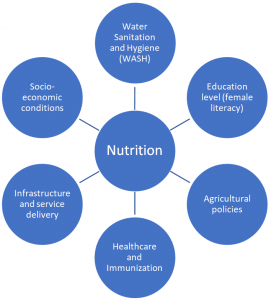 Figure 1: Factors influencing nutrition outcomes
Figure 1: Factors influencing nutrition outcomes
At the household level, nutritional outcomes are influenced by several factors (Figure 2). Household nutritional security depends not only on the availability, accessibility, and affordability of food but also on the knowledge of the importance of nutritional value of the food consumed. Deficient or highly variable income is one cause of food insecurity and malnutrition. Despite higher incomes, poor eating habits, lack of knowledge about good nutritional practices and limited access to diverse food items are also important determinants (Kachelriess-Matthess et al., 2016).
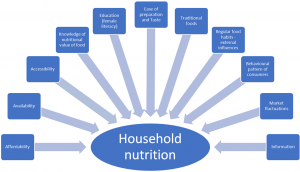 Figure 2: Factors affecting household nutrition
Figure 2: Factors affecting household nutrition
| Box 1: Different ways of addressing nutrition Nutrition-specific interventions or programmes are those that address the immediate determinants of foetal and child nutrition and development — adequate food and nutrient intake, feeding, care giving and parenting practices, and low burden of infectious diseases. The nutrition-specific interventions highlighted in LANCET series (June 2013), included adolescent and maternal nutrition, promotion of optimal breastfeeding and Infant and Young Child Feeding Practices, food and micronutrient supplementation programmes for young children and in pregnancy and lactation, prevention and management of severe acute malnutrition, and disease prevention and management. Nutrition-sensitive interventions or programmes are those that address the underlying determinants of foetal and child nutrition and development — food security, adequate caregiving resources at the maternal, household and community levels, access to health services, and a safe and hygienic environment — and incorporate specific nutritional goals and actions. Nutrition-sensitive interventions reviewed included agriculture, social safety nets, early child development and schooling. Source: Ruel and Alderman (2013). |
The Government of India took a step to tackle malnutrition by launching the National Nutrition Strategy (POSHAN Abhiyaan). The POSHAN Abhiyaan recognizes the need for multi-stakeholder coordination, and calls upon multiple sectors to combat nutrition and food insecurity in the country. It aims to synergize resources, departments, and frontline workers by leveraging technology to achieve the desired goals.
| Box 2: POSHAN Abhiyaan The Prime Minister’s Overarching Scheme for Holistic Nutrition (POSHAN) Abhiyaan or National Nutrition Mission, is the Government of India’s flagship programme to improve nutritional outcomes for children, pregnant women, and lactating mothers. Launched in 2018, the programme directs the attention of the country towards the problem of malnutrition and addresses it in a mission-mode to significantly reduce malnutrition by 2022. NITI Aayog has been entrusted with the task of closely monitoring the POSHAN Abhiyaan and undertaking periodic evaluations. POSHAN Abhiyaan has a four-point implementation strategy/pillars: -Inter-sectoral convergence for better service delivery; -Use of technology (ICT) for real time growth monitoring and tracking of women and children; -Intensified health and nutrition services for the first 1000 days of a newborn’s life; -Jan Andolan. Source: https://niti.gov.in/poshan-abhiyaan |
Since 2018, the month of September is being celebrated in India as Rashtriya POSHAN Maah. In 2019 during the POSHAN Maah the focus was on complementary feeding, treatment, and preventing infections in children.
The Rashtriya POSHAN Maah in 2020 has two major activities at the grassroots level – identification and tracking of children with Severe Acute Malnutrition (SAM) and plantation drives to promote kitchen gardens. In recent announcements, as part of the ‘POSHAN Maah’ celebrations the AYUSH Ministry has also been included and nutrition solutions based on traditional healthcare wisdom will become an integral part of the POSHAN Abhiyaan.
However, in the implementation of POSHAN Abhiyaan, the focus seems to have been largely on setting up the ICDS-CAS (common application software) mechanism for real-time monitoring of anganwadi services and conducting public awareness campaigns on malnutrition (Sinha, 2020). While this has helped bring the issue to the forefront, POSHAN Abhiyaan needs to be made more comprehensive by ensuring convergence of services and functioning as a platform where multi-sector interventions, including agriculture and food systems, gender and childcare can be regularly monitored at a decentralized level, along with nutritional outcomes.
MAKING AGRICULTURE NUTRITION-SENSITIVE
Currently, there is increasing recognition on the need for making agriculture nutrition-sensitive. FAO has defined Nutrition-sensitive Agriculture (NSA) as a food-based approach to agricultural development that puts nutritionally rich foods, dietary diversity, and food fortification at the heart of overcoming malnutrition and micronutrient deficiencies (FAO, 2014). This approach stresses the multiple benefits derived from enjoying a variety of foods, recognizing the nutritional value of food for good nutrition, and the importance and social significance of the food and agricultural sector for supporting rural livelihoods. The overall objective of nutrition-sensitive agriculture is to make the global food system better equipped to produce good nutritional outcomes.
Ruel and Alderman (2013) identified six pathways through which agricultural interventions can impact nutrition:
(1) food access from own-production;
(2) income from the sale of commodities produced;
(3) food prices from changes in supply and demand;
(4) women’s social status and empowerment through increased access to, and control over, resources;
(5) women’s time through participation in agriculture, which can be either positive or negative for their own nutrition and that of their children; and
(6) women’s health and nutrition through engagement in agriculture.
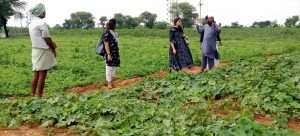 Demonstrating vegetable cultivation at Jarapula Thanda village, Nalgonda District, Telangana by Action for Rural Development Society, NGO.
Demonstrating vegetable cultivation at Jarapula Thanda village, Nalgonda District, Telangana by Action for Rural Development Society, NGO.
In India, several organisations are involved in addressing nutrition (Table 1), each one of them approaches nutrition from a different perspective. However, all these organisations are not fully realising the potential of agriculture in nutrition interventions.
Table 1: Nutrition interventions in India
| No. | Nature of intervention | Organisations involved |
| 1 | Supplementary Feeding | ICDS/Anganwadis (Department of Women and Child Welfare), Department of Tribal Welfare |
| 2 | Mid-day Meals | Department of Education |
| 3 | Vaccination, Immunization, First Aid, Distribution of tablets, Health Extension | Commissionerate of Health and Family Welfare-
PHCs/ASHA Workers |
| 4. | Research (Technical and Socio-economic) | ICMR-National Institute of Nutrition (NIN),
International Crops Research Institute for the Semi-Arid Tropics (ICRISAT), Agriculture Universities
|
| 5 | Nutrition Education | ICMR-NIN, Agriculture Universities, KVKs, NGOs |
| 6 | Varietal Improvement Fortification | ICAR-Indian Institute of Millets Research (IIMR), ICRISAT, Agriculture Universities, ICAR-Indian Institute of Rice Research (IIRR) |
| 7 | Incubation/Enterprise promotion | ICAR-IIMR, ICRISAT, National Institute of Agricultural Extension Management (MANAGE) |
| 8 | Value Addition/
Development of new products |
ICAR-IIMR, ICRISAT |
| 9 | Advocacy | UNICEF |
| 10 | Capacity Development of Staff | Agriculture – MANAGE, SAMETI, EEI
Nutrition/Health – ICMR-NIN, Agriculture Universities Rural Development – National Institute of Rural Development and Panchayat Raj (NIRD&PR) |
| 11 | Handholding support/Programme strengthening | UNICEF, TATA Trusts, UN-FAO |
| 12 | Crop Diversification
(Advice/Training/Demonstrations) |
State Department of Agriculture (DoA), State Department of Horticulture (DoH), Krishi Vigyan Kendra (KVKs) |
| 13 | Millet Promotion | DoA/NFSM-Nutricereals, ICRISAT |
| 14 | Distribution of Seeds/seedlings | DoA, DoH, KVKs |
| 15 | Policy Engagement | UNICEF, UN-FAO, TATA Trusts |
| 16 | Kitchen Gardens | Ministry of Human Resource and Development |
Source: FAO and AESA (Forthcoming)
In India, MS Swaminathan Research Foundation (MSSRF) proposed a Farming System for Nutrition (FSN) approach to contribute towards enhancing food security and nutrition for large sections. At its core, the approach calls for improving agricultural production diversity by incorporating an integrated farming system involving crops, livestock, and aquaculture in the field or in the homestead. Other core domains that can directly improve the local availability of deficient nutrients include agricultural production, biofortification, and agricultural value chains. Indirect or non-core domains that supplement the food related processes include nutrition-education, women’s empowerment, sanitation, hygiene, safe drinking water, and natural resource management. MSSRF has been engaged in advocacy for a FSN approach in Andhra Pradesh, Bihar, Maharashtra, and Odisha (MSSRF, 2018).
MAKING EAS NUTRITION-SENSITIVE
‘Extension workers are often thought of as the vehicle to the improved nutritional health of rural communities because they reach and interact closely with farmers in different settings. Furthermore, they act as significant service providers of crop, livestock, and forestry aspects of food security, consumption, and production. It is often thought that service providers within agriculture should focus on aspects of nutrition, and service providers within health should focus on factors around malnutrition’ (Fanzo et. al., 2013).
‘EAS, with their established infrastructure, provide a unique opportunity for nutrition interventions to be implemented at scale with significant reach’ (ibid. 2). The rationale to address nutrition through EAS is to leverage the strengths of the existing infrastructure of the EAS as they have reach; have an established infrastructure and have community trust and cultural awareness to a certain extent. In most cases, EAS also lack understanding of the food consumption pattern of its clients. ‘The nutrition training of extension agents is often inadequate, particularly in the realm beyond technical agricultural skill. Additionally, a lack of career opportunities discourages EAS agents from engaging with nutrition integration’ (ibid. 3).
In India, the EAS are not addressing nutrition in their work. By and large the core expertise of the public sector EAS has been on production of food crops (mainly cereals) and export crops in which the governments are interested. The field level extension personnel of the state departments of agriculture are mostly engaged in implementation of government schemes. Addressing malnutrition is not a mandate for most of the Departments of Agriculture in India. (Recently the state of Odisha has made achieving nutrition security one of its mission directives under its new Agricultural Policy 2020.)
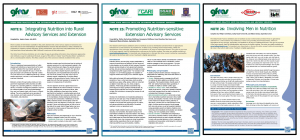 GFRAS Global Good Practices on Nutrition Sensitive Extension
GFRAS Global Good Practices on Nutrition Sensitive Extension
Training on Nutrition Sensitive Agriculture is not a part of the staff training of the Department of Agriculture in many states. In the case of KVKs, nutrition is considered as the responsibility of the SMS (Home Science) but they struggle to do meaningful work given the limited budget they have. During Poshan Maah 2020, all KVKs in India organised a one-day training programmes for ICDS/Anganwadi workers and farm women and distributed seeds and seedlings of vegetables to establish nutri-gardens.
Only recently, has there been a renewed focus on addressing the issue of malnutrition in India through agricultural interventions (for example: Millet Mission, policies to improve the nutrient content of processed foods, etc.). The Indian Council of Agricultural Research and the Agricultural Universities have introduced several biofortified varieties to combat micronutrient deficiencies. ‘However, farmers are not eager to grow such crops as there is no remunerative price for biofortified grains in the market. Strengthening the seeds chain to produce and supply good quality seeds is an important step for the popularization of biofortified varieties of different crops’ (Yadava et al., 2018).
The private sector, whether it is input companies or those engaged in agri-business, is more focused on input and output markets and nutrition is not their focus. Only very few NGOs, especially those working with smallholders and women, have some interest in this theme and there is a lot to learn from them. These examples are discussed below.
In its endeavour to improve nutritional security, the Reliance Foundation has supplemented the nutritional intake of rural households through promotion of small kitchen or backyard gardens, known as ‘Reliance Nutrition Gardens’ (RNGs). These RNGs help improve the nutrition status of small and marginal farmers and their families, providing them with a diverse mix of vegetables, fruits and medicinal plants throughout the year so as to meet the balanced dietary requirements of marginal rural households. Till date, more than 29,000 RNGs have been established. The RNG model has witnessed remarkable success and have actively helped reverse malnutrition trends in 26 programme operational clusters, improving the health and immunity of the community, especially women (Nutrition Security – Reliance Foundation 2020).
In Odisha, Living Farms, an NGO – with the support of Azim Premji Philanthropic Initiatives – addressed the underlying causes of malnutrition using a model that interlinked agriculture, food security and natural resources, which are usually seen as independent of each other and not linked to nutrition. The programme was called ‘Participatory Learning and Action – Linking Agriculture to Nutrition and Natural Resources’ (PLA-LANN). It aimed to improve dietary diversity and nutritional outcomes in eight blocks of Rayagada and Kalahandi districts in Odisha State. The project used a participatory approach, including community meetings, group counselling, individual home visits to target groups, and supply of garden inputs (seeds) to achieve a balanced and diverse diet for approximately 300,000 Adivasis. A study conducted to assess the impact of the programme showed statistically significant impact in the key indicators of maternal dietary diversity, Infant and Young Child Feeding (IYCF) practices, and nutrition outcomes (Verma and Sarangi, 2020).
In Telangana, Society for Elimination of Rural Poverty (SERP) and Centre for Sustainable Agriculture (CSA) are implementing the ‘Half acre model’ in a partnership mode to meet the nutritional requirements from vegetables (recommended intake – 325 grams of vegetables per day per person) for the poorest of the poor in select villages in Telangana. The purpose of this programme is to help women farmers meet their own nutritional requirements from vegetables, and for creating an opportunity for a regular source of income for women farmers who adopt this half-acre model. The training on technical aspects is provided by CSA. The vegetables grown on the plot are based on what is locally feasible (suitable and locally consumable) and on a staggered production design and handling that provides a regular income throughout the year for the entrepreneur from selling the surplus vegetables in the village after self-consumption. The half-acre model is agronomically designed to prevent production problems, reduce risks, and avoid drudgery for women in the production process. So far the project has reached 23 households in 23 villages in the year 2019. It plans to scale this programme to 1700-1800 households (one person from one village) in the next stage.
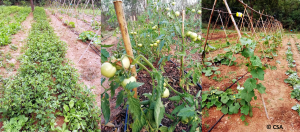 Staggered vegetable production for regular supply of vegetables by CSA
Staggered vegetable production for regular supply of vegetables by CSA
A study in eight villages of Medak district of Andhra Pradesh (now Telangana), assessed the impacts of introducing a homestead garden and backyard poultry (BYP), an intervention linked to the Integrated Child Development Services (ICDS), over a period of three years. The goal was to address the issue of micronutrient deficiency in diets through health and nutrition education, introduction of homestead gardens and backyard poultry with high egg-yielding birds in a rural community. The target was pregnant women and mothers with pre-school children aged 6–24 months registered with the 11 Integrated Child Development Services (ICDS) centres. The Knowledge, Attitude and Practice (KAP) survey responses showed that the percentage of families raising homestead gardens increased from 30% initially to over 70% finally. Weekly mean frequency of cooked green leafy vegetables (GLV), increased from 1.9 to 2.4. The percentage of households cooking GLV more than three times per week increased from 21 in the initial survey to 45 in the final survey. Weekly frequency and quantity of eggs consumed, among households who set up BYP, more than doubled. ICDS records showed gradual decline in percentage of 6 to 24-month-old children suffering from moderate-to-severe malnutrition, over the three-year experimental period (Murty et al., 2016).
All these examples show how EAS can address nutrition. The key opportunities for integration of nutrition into EAS involve engaging communities, creating a demand for nutrition, use of innovative communications, and education on general nutrition, food groups, food hygiene, and food preparation.
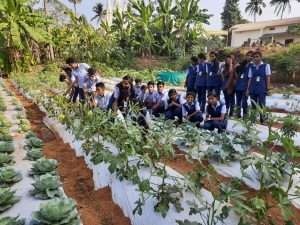 A School Nutrition Garden in Kerala
A School Nutrition Garden in Kerala
For effective implementation of EAS, there is a dire need to do the following:
- Strengthen training on Nutrition Sensitive Agriculture through extension training centres (MANAGE, EEIs, KVKs);
- Support development of training modules on Nutrition Sensitive Agriculture for field extension workers;
- Mandate KVKs and the state Department of Agriculture to strengthen school nutrition gardens as proposed by the MoHRD, 2019.;
- Map locally available nutritious food and promote these (Yesudas BS, 2020);
- Formulate a policy on Nutrition Sensitive Agriculture at the state level;
- Organise nutrition education programmes for rural women;
- Organise training for the staff of anganwadis on how agricultural interventions can address nutrition challenges of their clients.
CONCLUSION
We are at a stage where we all understand and agree that a holistic and systematic approach is required to address the challenges of global hunger and malnutrition in a sustainable way. It is widely accepted that an investment in food-based solutions for communities can ensure security and offer better outcomes.
At the organizational level, many organisations lack capacities to engage in joint/collaborative action with other agencies working in the area of nutrition. EAS can better address the issue of under-nutrition, if for instance, the Department of Agriculture could collaborate with the agencies involved in Health, Nutrition, Women and Child Development as well as Education. ‘Systematic reviews indicate that cross-sector approaches requiring collaboration among and across a range of stakeholders can lead to better nutrition and health outcomes’ (USAID, 2016).
At the individual level, Agriculture Extension Service providers should be equipped with enough knowledge and resource materials to give appropriate advice to farmers. There is a dire need to focus on the capacity building of agriculture extension workers on the nutrition dimension. With the increased attention on, and investment in, nutrition-sensitive agriculture, EAS is an important potential contributor for delivering effective nutrition to rural farming communities. Utilising the EAS and making agriculture more nutrition-sensitive requires the identification of critical points where nutrition goals could be incorporated. It also requires a new way of thinking, planning, implementing, and partnering, as well as the active engagement of a variety of stakeholders from multiple sectors.
References
Fanzo, J., Marshall, Q., Wong, J., Merchan, R. I., Jaber, M. I., Souza, A., & Verjee, N. (2013). The integration of nutrition into extension and advisory services: A synthesis of experiences, lessons, and recommendations. Lindau, Switzerland: Global Forum for Rural Advisory Services.
FAO. (2014, November 19-21). The Second International Conference on Nutrition: Committing to a future free of malnutrition. Food and Agriculture Organization of the United Nations, Rome. http://www.fao.org/3/a-i4465e.pdf
FAO., & AESA (forthcoming). Capacity needs assessment for integrating nutrition objectives into agricultural/extension and advisory services programmes and policies. Telangana state. India.
Global nutrition report. (2020). Global nutrition report: Action on equity to end malnutrition. Development Initiatives Poverty Research Ltd, UK. https://globalnutritionreport.org/reports/2020-global-nutrition-report/
Global Panel on Agriculture and Food Systems for Nutrition. (2014). How can Agriculture and Food System Policies improve Nutrition? Technical Brief, London, UK: Global Panel on Agriculture and Food Systems for Nutrition.
Headey, D., Heidkamp, R., Osendarp, S., Ruel, M., Scott, N., Black, R., Shekar, M., Bouis, H., Flory, A., Haddad, L., Walker, N., & Standing Together for Nutrition consortium. (2020). Impacts of COVID-19 on childhood malnutrition and nutrition-related mortality. Lancet (London, England), 396(10250), 519–521. https://doi.org/10.1016/S0140-6736(20)31647-0
Kachelriess-Matthess, S., Matthess, A., Stancher, A., Asare, B., & Afoakwa, E.O. (2016). Promoting nutrition-sensitive extension advisory services. Note 25. Good Practice Notes for Extension and Advisory Services. Lindau, Switzerland: Global Forum for Rural Advisory Services. https://www.g-fras.org/en/good-practice-notes/25-promoting-nutrition-sensitive-extension-advisory-services.html
MoHRD. (2019). School nutrition (Kitchen) gardens guidelines. Ministry of Human Resource Development, Government of India, New Delhi.
MSSRF. (2018). Farming system for nutrition: A pathway for addressing malnutrition in India policy recommendations. M S Swaminathan Research Foundation. Chennai. http://59.160.153.188/library/sites/default/files/Policy%20Recommendations%20Final%2027%20Mar%2019.pdf
Murty, P. V. V. S., Rao, M. V., & Bamji, M. S. (2016). Impact of enriching the diet of women and children through health and nutrition education, introduction of homestead gardens and backyard poultry in rural India. Agricultural Research, 5, 210–217. http://dx.doi.org/10.1007/s40003-016-0206-x.
Nutrition Security. (2020). In Reliance Foundation Online. Reliance foundation Mumbai India. https://www.reliancefoundation.org/nutrition-security
Ruel, M & Alderman, H. (2013). Nutrition-Sensitive interventions and programmes: how can they help to accelerate progress in improving maternal and child nutrition?. The Lancet, 382(9891), 536-551.
Ruel, M., Quisumbing, A., & Balagamwala, M. (2018). Nutrition-sensitive agriculture: What have we learned so far?. Global Food Security, 17, 128-153.
Sahasrabuddhe, V. (2020, June). Jan Andolan for a malnutrition free India, Justice on our plates- a symposium on how to solve the problem of malnutrition, Seminar 730. https://www.india-seminar.com/2020/730/730_vinay_sahasrabuddhe.htm
Sinha, D. (2020, June). The Problem, Justice on our plates- a symposium on how to solve the problem of malnutrition, Seminar-730. https://www.india-seminar.com/2020/730/730_the_problem.htm
USAID/SPRING. (2016). Operationalizing multi-sectoral coordination and collaboration for improved nutrition: Recommendations from an in-depth assessment of three countries’ experiences. Feed the Future.https://www.spring-nutrition.org/sites/default/files/publications/briefs/operational multisect_0.pdf
Verma, A., & Sarangi, D. (2020). For food security, community involvement is the key. Poshan Outlook, 1st July. https://poshan.outlookindia.com/story/poshan-news-for-food-security-community-involvement-is-thekey/355777#:~:text.
Yadava, D. K., Hossain, F., & Mohapatra, T. (2018). Nutritional security through crop biofortification in India: status & future prospects. Indian Journal of Medical Research, 148(5), 621-631. http://www.ijmr.org.in/article.asp?issn=09715916;year=2018;volume=148;issue=5;spage=621;epage=631;aulast=Yadava)
Yesudas, B. S. (2020). Blog 135- Local food systems for food and nutrition security: Implications for extension and advisory services. Agriculture Extension in South Asia, 28th September. https://www.aesanetwork.org/blog-135-local-food-systems-for-food-and-nutrition-security-implications-for-extension-and-advisory-services/
 Tejaswini Kaja holds a master’s degree in Public Policy and Governance from Azim Premji University with electives in environment policy, land use and land cover change and agrarian concerns. She has worked as a Senior Research Fellow at Centre for Research on Innovation and Science Policy (CRISP) on ‘Capacity needs assessment for integrating nutrition objectives into Agriculture/EAS programmes and policies’. Tejaswini has been associated with research on governance of commons, agricultural policies, food and nutrition security since her post graduation. She is now an independent consultant. (tejaswinikaja@gmail.com)
Tejaswini Kaja holds a master’s degree in Public Policy and Governance from Azim Premji University with electives in environment policy, land use and land cover change and agrarian concerns. She has worked as a Senior Research Fellow at Centre for Research on Innovation and Science Policy (CRISP) on ‘Capacity needs assessment for integrating nutrition objectives into Agriculture/EAS programmes and policies’. Tejaswini has been associated with research on governance of commons, agricultural policies, food and nutrition security since her post graduation. She is now an independent consultant. (tejaswinikaja@gmail.com)

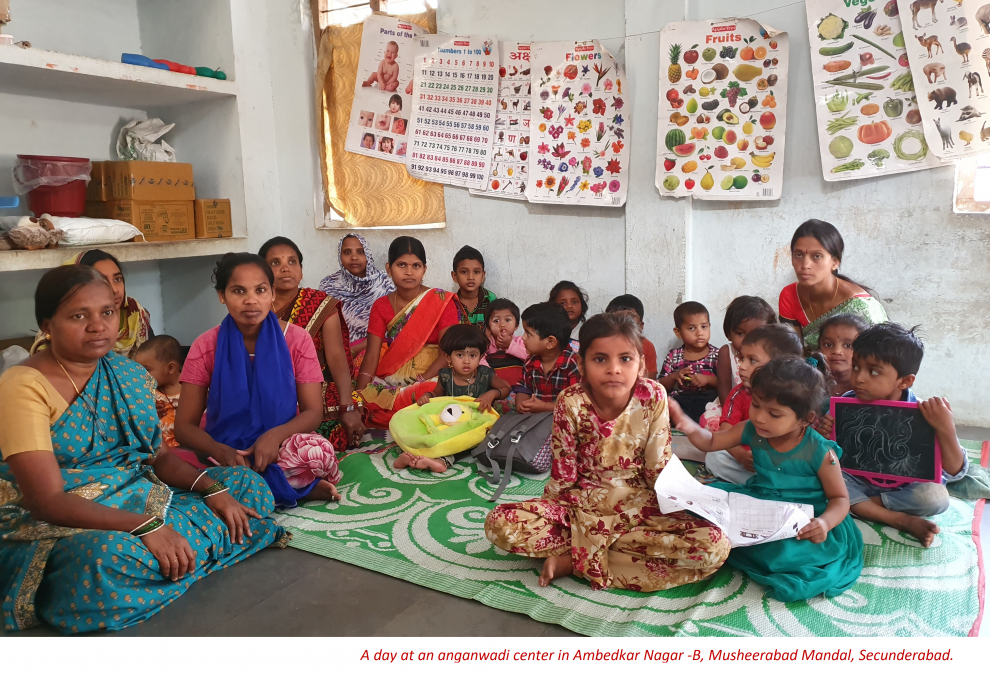



“I congratulate the author Tejaswini Kaja for coming out with various examples to show how the EAS can work to mitigate the malnutrition. It is well known that malnutrition is a complex issue and requires multi-pronged approaches with active collaboration from several agencies. To supplement these approaches mentioned by the author, I suggest that livestock extension agencies can play a major role in addressing the malnutrition especially in children and pregnant women vulnerable for anaemia and its consequent health issues. Consumption of animal protein is one of the best ways to reduce the incidence of anaemia especially in weaker sections. Hence, it is worth investing in promoting backyard poultry in the households (where there is a space for scavenging) through efficient and effective delivery of extension services (not distribution of chicks) which will improve the production of eggs and consumption of eggs and chicken as was demonstrated in several villages in the country. Similarly, it is good to revive the inclusion of eggs and milk in the midday meal scheme as and when the schools are reopened. This will also address the problem of high per capita availability of milk and eggs and low per capita consumption in the households of economically weaker sections”